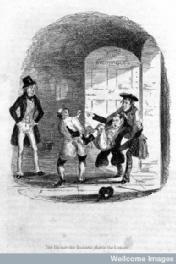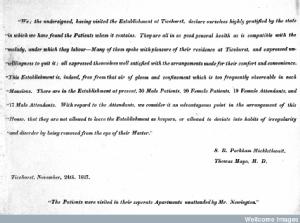TOPIC 3 (WEEK 4): INTRODUCTION
| The main focus of this session is the expansion of private asylums in the 18th century. We will seek to explain this very English phenomenon of the development of a private system of care based on profit. The trade in lunacy focused on the very poor, Poor Law patients, but, at the other extreme, was a highly lucrative enterprise catering for the wealthy patient and his/her family. We will work our way through early legislation which attempted to regulate madhouses, paying special attention to the issue of ‘wrongful confinement’. We will also explore ‘the patient’s view’ through Alexander Cruden’s account of his incarceration in a London madhouse. You should all read the Allan Ingram document, long and laborious though it is! Then ensure that you read at least two items from the ** seminar reading. I shall ask one volunteer to focus on Len Smith's ‘A Gentleman’s Mad-Doctor', that explores an asylum for the well-to-do, and another to examine his piece on Thomas Bakewell’s Spring Vale Asylum. Have a look too at the materials related to the play, 'The Trade in Lunacy', video and podcasts and supporting essays/programme notes. |
 |
QUESTIONS
- How and why did the private asylum trade develop in 18th century England?
- Private asylums were lucrative enterprises, but provided little theraputic aid to their patients. Do you agree?
- Did private asylums serve patients, doctors or families?
- What can Cruden's account of his incarceration tell us about 18th century asylums and the 'care' of the insane?
DOCUMENTS
All have a look at the materials relating to the chamber theatre production we developed with Talking Birds, 'The Trade in Lunacy' which took place in Coventry in June 2013. There is a video of the performance and panel discussion, as well as some useful short essays on the private asylum trade:
http://www2.warwick.ac.uk/fac/arts/history/chm/outreach/trade_in_lunacy/** Allan Ingram, Voices of Madness: Four Pamphlets, 1683-1796 (Stroud: Sutton, 1997), esp. Alexander Cruden, ‘The London-Citizen Exceedingly Injured, 1739’, pp. 23-74. (There are other useful essays in this volume.) The Cruden account is available on-line, in the ECCO collection (Eighteenth Century Collections Online, type in 'Cruden London Citizen) and via Talis Aspire.
READING
|
PRIVATE MADHOUSES
** Roy Porter, Mind-Forg’d Manacles: A History of Madness in England from the Restoration to the Regency (London: Athlone, 1987; Penguin edn, 1990), especially ch. 3. Multiple copies in library and e-book
** Leonard Smith, Private Madhouses in England, 1640-1815: Commercialised Care for the Insane (Cham: Palgrave Macmillan, 2020), especially chs 3 and 4. e-book
** William Ll. Parry-Jones, The Trade in Lunacy: A Study of Private Madhouses in England in the Eighteenth and Nineteenth Centuries (London: Routledge & Kegan Paul, 1972). e-book
Roy Porter, A Social History of Madness: Stories of the Insane (London: Weidenfeld and Nicolson, 1987), ch. 7 ‘From Fools to Outsiders’ (includes material on Cruden). Multiple copies in library
Roy Porter, Madmen: A Social History of Madhouses, Mad-Doctors and Lunatics (Stroud: Tempus, 2004) (ch. 3). Multiple copies in library
Andrew Scull, The Most Solitary of All Afflictions: Madness and Society in Britain, 1700-1900 (Yale University Press, 1993), ch. 1. Multiple copies in library and a possible Amazon purchase
** Andrew Scull, Madness in Civilization (London: Thames & Hudson, 2015), ch. 5. Multiple copies in library
|
 |
**L.D. Smith, ‘To Cure those Afflicted with the Disease of Insanity: Thomas Bakewell and Spring Vale Asylum’, History of Psychiatry, 4 (1993), 107-27. e-journal
** Elizabeth Foyster, ‘At the Limits of Liberty: Married Women and Confinement in Eighteenth-Century England’, Continuity and Change, 17 (2002), pp.39-62. e-journal
Jonathan Andrews and Andrew Scull, Undertaker of the Mind: John Munro and Mad-Doctoring in Eighteenth-Century England (University of California Press, 2001).
Jonathan Andrews and Andrew Scull, Customers and Patrons of the Mad Trade: The Management of Lunacy in Eighteenth-Century London (University of California Press, 2003).
* L.D. Smith, ‘Eighteenth-Century Madness Practice: The Prouds of Bilston’, History of Psychatiry, 3 (1992), 45-52. e-journal
Andrew Mason, ‘The Reverend John Ashburne (c.1611-61) and The Origins of the Private Madhouse System’, History of Psychiatry, 5 (1994), 321-45. e-journal
L.D. Smith, ‘Behind Closed Doors: Lunatic Asylum Keepers, 1800-1860’, Social History of Medicine, 3 (1988), 301-27. e-journal
Allan Ingram (ed.), Patterns of Madness in the Eighteenth Century: A Reader (Liverpool University Press, 1998). (Great extracts on many aspects of madness, including private mad-house experiences.) Several copies in library
Allan Ingram, Cultural Constructions of Madness in Eighteenth-Century Writing: Representing the Insane (Houndmills: Palgrave Macmillan, 2005). e-book
Allan Ingram, The Madhouse of Language: Writing and Reading Madness in the Eighteenth Century (London: Routledge, 1991).
Tobias Smollett, The Life and Adventures of Sir Launcelot Greaves (1st pub. 1760; Oxford University Press, 1973). (Includes mad-house episodes)
PRIVATE ASYLUMS FOR THE RICH
** Len Smith, ‘A Gentleman’s Mad-Doctor in Georgian England: Edward Long Fox and Brislington House’, History of Psychiatry, 19 (2008), 163-84. e-journal
Charlotte Mackenzie, Psychiatry for the Rich: A History of Ticehurst Private Asylum, 1792-1917 (London and NewYork: Routledge, 1992).
** Charlotte Mackenzie, ‘Psychiatry for the Rich: A History of the Private Madhouse at Ticehurst in Sussex, 1792-
1917’, Pyschological Medcine, 18 (1988), 545-9. e-journal


